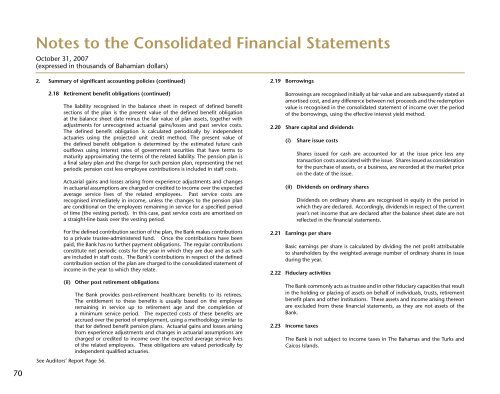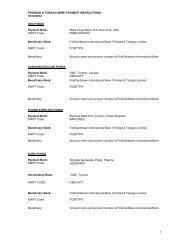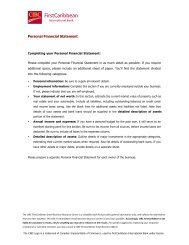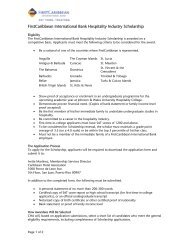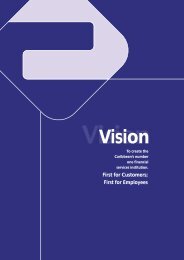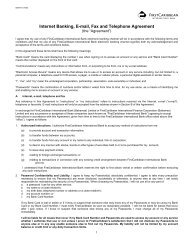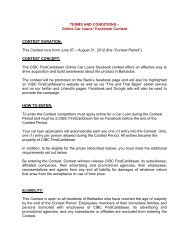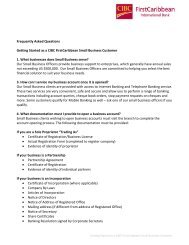Bahamas - FirstCaribbean International Bank
Bahamas - FirstCaribbean International Bank
Bahamas - FirstCaribbean International Bank
Create successful ePaper yourself
Turn your PDF publications into a flip-book with our unique Google optimized e-Paper software.
Notes to the Consolidated Financial Statements<br />
October 31, 2007<br />
(expressed in thousands of Bahamian dollars)<br />
70<br />
2. Summary of significant accounting policies (continued)<br />
2.18 Retirement benefit obligations (continued)<br />
The liability recognised in the balance sheet in respect of defined benefit<br />
sections of the plan is the present value of the defined benefit obligation<br />
at the balance sheet date minus the fair value of plan assets, together with<br />
adjustments for unrecognised actuarial gains/losses and past service costs.<br />
The defined benefit obligation is calculated periodically by independent<br />
actuaries using the projected unit credit method. The present value of<br />
the defined benefit obligation is determined by the estimated future cash<br />
outflows using interest rates of government securities that have terms to<br />
maturity approximating the terms of the related liability. The pension plan is<br />
a final salary plan and the charge for such pension plan, representing the net<br />
periodic pension cost less employee contributions is included in staff costs.<br />
Actuarial gains and losses arising from experience adjustments and changes<br />
in actuarial assumptions are charged or credited to income over the expected<br />
average service lives of the related employees. Past service costs are<br />
recognised immediately in income, unless the changes to the pension plan<br />
are conditional on the employees remaining in service for a specified period<br />
of time (the vesting period). In this case, past service costs are amortised on<br />
a straight-line basis over the vesting period.<br />
For the defined contribution section of the plan, the <strong>Bank</strong> makes contributions<br />
to a private trustee-administered fund. Once the contributions have been<br />
paid, the <strong>Bank</strong> has no further payment obligations. The regular contributions<br />
constitute net periodic costs for the year in which they are due and as such<br />
are included in staff costs. The <strong>Bank</strong>’s contributions in respect of the defined<br />
contribution section of the plan are charged to the consolidated statement of<br />
income in the year to which they relate.<br />
(ii) Other post retirement obligations<br />
See Auditors’ Report Page 56.<br />
The <strong>Bank</strong> provides post-retirement healthcare benefits to its retirees.<br />
The entitlement to these benefits is usually based on the employee<br />
remaining in service up to retirement age and the completion of<br />
a minimum service period. The expected costs of these benefits are<br />
accrued over the period of employment, using a methodology similar to<br />
that for defined benefit pension plans. Actuarial gains and losses arising<br />
from experience adjustments and changes in actuarial assumptions are<br />
charged or credited to income over the expected average service lives<br />
of the related employees. These obligations are valued periodically by<br />
independent qualified actuaries.<br />
2.19 Borrowings<br />
Borrowings are recognised initially at fair value and are subsequently stated at<br />
amortised cost, and any difference between net proceeds and the redemption<br />
value is recognised in the consolidated statement of income over the period<br />
of the borrowings, using the effective interest yield method.<br />
2.20 Share capital and dividends<br />
(i)<br />
Share issue costs<br />
Shares issued for cash are accounted for at the issue price less any<br />
transaction costs associated with the issue. Shares issued as consideration<br />
for the purchase of assets, or a business, are recorded at the market price<br />
on the date of the issue.<br />
(ii) Dividends on ordinary shares<br />
Dividends on ordinary shares are recognised in equity in the period in<br />
which they are declared. Accordingly, dividends in respect of the current<br />
year’s net income that are declared after the balance sheet date are not<br />
reflected in the financial statements.<br />
2.21 Earnings per share<br />
Basic earnings per share is calculated by dividing the net profit attributable<br />
to shareholders by the weighted average number of ordinary shares in issue<br />
during the year.<br />
2.22 Fiduciary activities<br />
The <strong>Bank</strong> commonly acts as trustee and in other fiduciary capacities that result<br />
in the holding or placing of assets on behalf of individuals, trusts, retirement<br />
benefit plans and other institutions. These assets and income arising thereon<br />
are excluded from these financial statements, as they are not assets of the<br />
<strong>Bank</strong>.<br />
2.23 Income taxes<br />
The <strong>Bank</strong> is not subject to income taxes in The <strong>Bahamas</strong> and the Turks and<br />
Caicos Islands.


